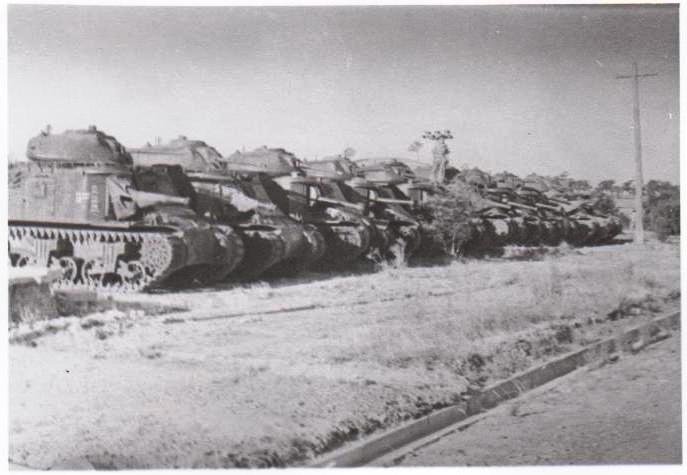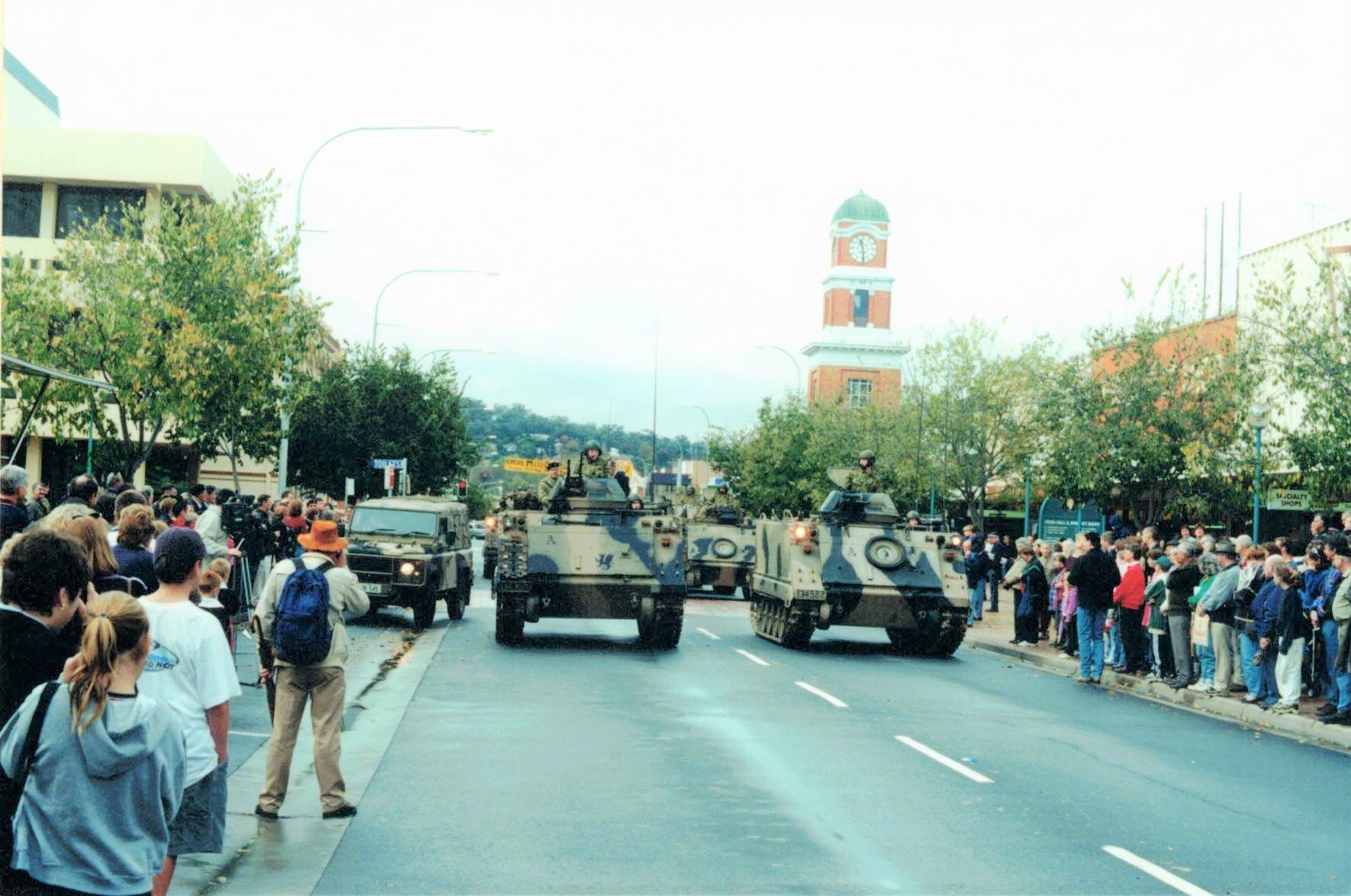ARMY LEAVES ALBURY AFTER 115 YEARS
On Saturday 13 May 2000, Victorian Mounted Rifles Squadron, 4th/19th Prince of Wales's Light Horse Regiment departed the Drill Hall Albury and relocated to its new depot at Building 105 North Bandiana.
This event signified the end of an Army presence in Albury which began in 1886 when an NSW Volunteer Infantry Company was formed under the command of Captain Foster Cooper.
H Company 1st New South Wales Infantry training at Albury Showground 1889.
Photograph Albury City Collection.
The Drill Hall in Victoria Street was constructed in 1900 on portion of the Police Paddock and opened as a training depot for citizen soldiers of the town. With Federation came a change of role for the soldiers, from infantry to field artillery. Guns, wagons, and horse teams became a common sight as the battery trained for war.
Albury Drill Hall, centre building, constructed in 1900. Flanking buildings were added c. 1915. The complex was vacated in 2000 and demolished for redevelopment in 2004.
Many more of the town’s young men came to the Drill Hall when compulsory training was introduced in 1911. In addition to the Battery, an infantry company under the command of Captain James Simpson was formed.
War came in 1914 and the Albury Battery proceeded overseas under the command of Major Joseph Shellshear. The battery fought on the Western Front with notable roles in the battles at Noreuil and Mont St Quentin.
Following the War, the Battery recommenced training at Victoria Street and continued till the outbreak of the Second World War. Majors Roy Collings MC and Leslie Colquhoun filled command positions. In 1940, the Battery mobilised and moved north; in its absence the depot became home to various military base units.
A Sub-Section 60th Battery Australian Field Artillery training at Albury Drill Hall 1921.
Post-war soldiering resumed in 1948 with the formation of the 8th/13th Victorian Mounted Rifles, a tank regiment of the Royal Australian Armoured Corps. National Service in 1951 brought another influx of Albury and Wodonga young men to the Drill Hall. The ranks of the VMR swelled to hundreds and General Grant tanks and sleek scout cars flying pennants on radio antenna rumbled through the city streets as the regiment moved out on weekend manoeuvres in the surrounding countryside. Colonel John Neale was one regimental commander.
8/13 Victorian Mounted Rifles engaged in an annual training camp with General Grant tanks at Puckapunyal 1954. There were adequate numbers of General Grants to allow regimental sized exercises to be conducted.
Ferret Scout Cars and M113 Light Reconnaissance Vehicles (LRVs) about to depart Albury Drill Hall to conduct a weekend exercise, c.1970.
The closure of the Drill Hall on 13 May 2000 and the relocation of the squadron from Albury brought that all to an end. The subsequent demolition of the buildings and the redevelopment into a prestige housing estate further wiped away all trace of Albury’s military heritage.
Victorian Mounted Rifles Squadron, 4/19 Prince of Wales’s Light horse mounted in M113 Light Reconnaissance Vehicles (LRVs) parading along Dean Street Albury marking its relocation to North Bandiana, 13 May 2000.
The squadron marked its departure in style, however. Mounted in tracked armoured fighting vehicles and led by a section of light horse and the regimental band, the parade moved down Dean Street past an honour guard of Army Cadets and a saluting dais. On the dais, the mayor of the City of Albury, Councillor Les Langford took the salute and farewelled the regiment. This ended 115 years of Albury as a garrison city.
Parade approaching the saluting dais in Dean Street Albury where the Mayor of Albury, Councillor Les Langford, farewelled the regiment.
The squadron marched on. In Wodonga it was welcomed by Councillor Graham Crapp, mayor of the City of Wodonga. Councillor Crapp accompanied the regiment to the gates of North Bandiana Army Base where the Commander Bandiana Area, Colonel Chris Anstey greeted the regiment and handed over Building 105 to the Commanding Officer of the 4th/19th Prince of Wales's Light Horse, Lieutenant Colonel Michael Annett.
The squadron accompanied by the Mayor of Wodonga, Councillor Graham Crapp, met the Commander Albury-Wodonga Military Area, Colonel Christopher Anstey, at the gateway to Building 105 North Bandiana. Naval and Army cadets mounted an honour guard at the gate. Lieutenant Colonel Michael Annett Commanding Officer 4/19 Prince of Wales’s Light Horse is at left.
Building 105 had been constructed in 1942 as part of the rapid development of the Bandiana as Australia’s largest World War Two military logistic base. For fifty years it was the Royal Australian Electrical and Mechanical Engineers (RAEME) Armaments Wing able to repair and refurbishment the largest guns and tanks the army possessed.
The squadron enters Building 105, North Bandiana for the first time. The spacious and recently re-roofed and re-clad building promised to become a superb training facility. Alas this promise was to be short lived. Serious structural defects emerged and in 2009 the building was declared unsafe and the squadron moved to a new home.
The building, an imposing structure, was testament to the carpentry skills of an earlier generation. It was constructed entirely of hardwood timber with bolted joints. Lattice columns supported framed roof trusses.
Prior to the 2000 move-in of the armoured squadron, the building had been refurbished, but no amount of refurbishment could compensate for the structural deterioration caused by ageing roof sheeting which allowed moisture to enter. In 2009 the building was declared unsafe, and the unit moved again, first to temporary accommodation at Bandiana then further out to its current depot at Latchford Barracks, Bonegilla. No parade or ceremony marked these moves.
The departure from Albury together with other outside factors precipitated a decline in the number of soldiers from the district. At the time of the move there were 50, now there are fewer than 20. The citizen soldier of the Army Reserve has close links to the community. When he and his activities are no longer visible, he fades from communal consciousness and consequently the option for young men and women to participate disappears.








